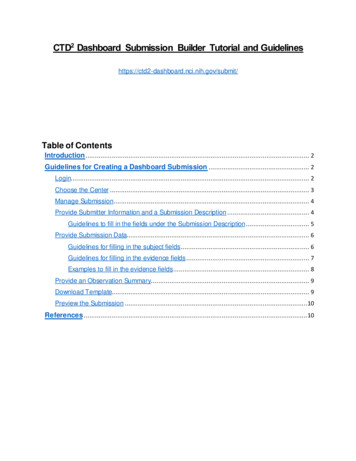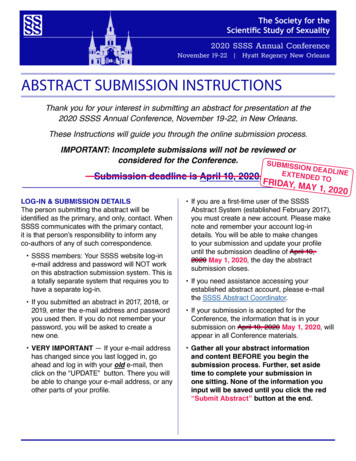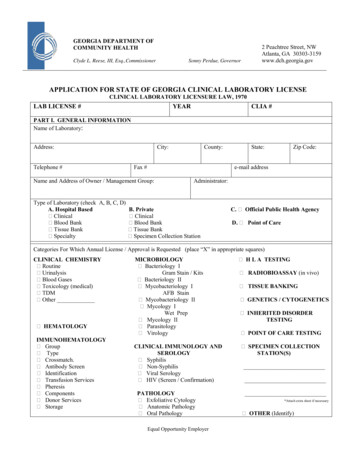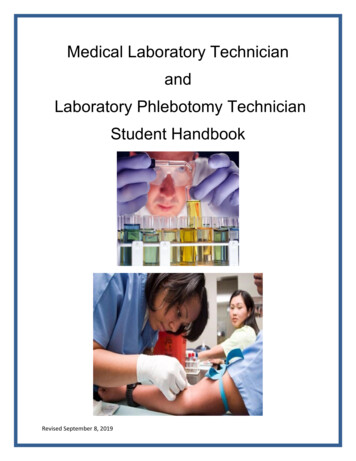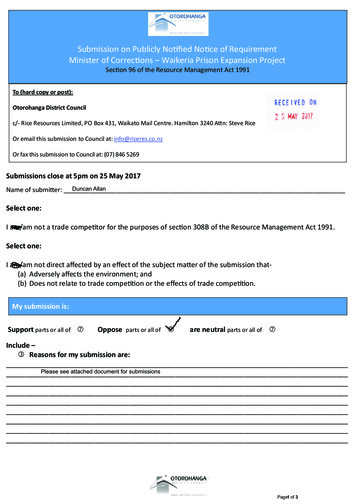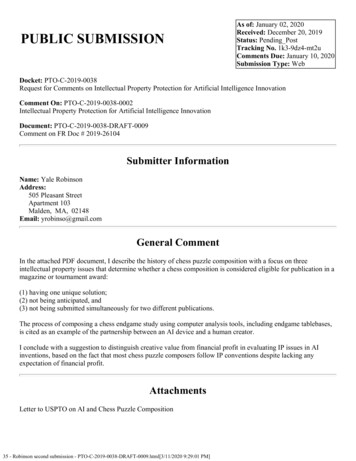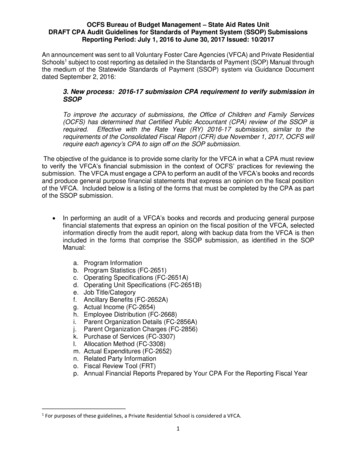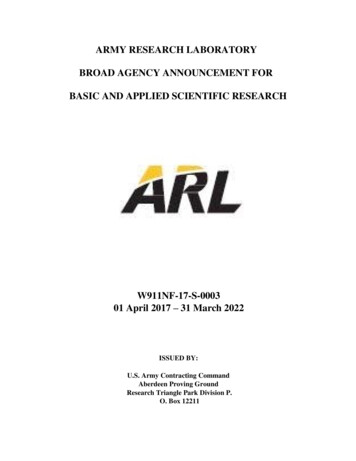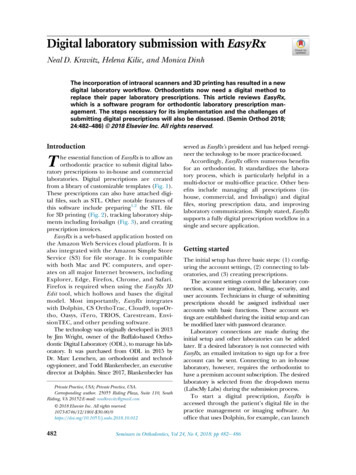
Transcription
Digital laboratory submission with EasyRxD1X XNeal D. KravitzD2X X, D3X XHelena KilicD4X X, and D5X XMonica DinhD6X XThe incorporation of intraoral scanners and 3D printing has resulted in a newdigital laboratory workflow. Orthodontists now need a digital method toreplace their paper laboratory prescriptions. This article reviews EasyRx,which is a software program for orthodontic laboratory prescription management. The steps necessary for its implementation and the challenges ofsubmitting digital prescriptions will also be discussed. (Semin Orthod 2018;24:482–486) 2018 Elsevier Inc. All rights reserved.IntroductionThe essential function of EasyRx is to allow anorthodontic practice to submit digital laboratory prescriptions to in-house and commerciallaboratories. Digital prescriptions are createdfrom a library of customizable templates (Fig. 1).These prescriptions can also have attached digital files, such as STL. Other notable features ofthis software include preparing1,2 the STL filefor 3D printing (Fig. 2), tracking laboratory shipments including Invisalign (Fig. 3), and creatingprescription invoices.EasyRx is a web-based application hosted onthe Amazon Web Services cloud platform. It isalso integrated with the Amazon Simple StoreService (S3) for file storage. It is compatiblewith both Mac and PC computers, and operates on all major Internet browsers, includingExplorer, Edge, Firefox, Chrome, and Safari.Firefox is required when using the EasyRx 3DEdit tool, which hollows and bases the digitalmodel. Most importantly, EasyRx integrateswith Dolphin, CS OrthoTrac, Cloud9, topsOrtho, Oasys, iTero, TRIOS, Carestream, EnvisionTEC, and other pending software.The technology was originally developed in 2013by Jim Wright, owner of the Buffalo-based Orthodontic Digital Laboratory (ODL), to manage his laboratory. It was purchased from ODL in 2015 byDr. Marc Lemchen, an orthodontist and technology-pioneer, and Todd Blankenbecler, an executivedirector at Dolphin. Since 2017, Blankenbecler hasPrivate Practice, USA; Private Practice, USA.Corresponding author. 25055 Riding Plaza, Suite 110, SouthRiding, VA 20152 E-mail: nealkravitz@gmail.com 2018 Elsevier Inc. All rights reserved.1073-8746/12/1801- 82served as EasyRx’s president and has helped reengineer the technology to be more practice-focused.Accordingly, EasyRx offers numerous benefitsfor an orthodontist. It standardizes the laboratory process, which is particularly helpful in amulti-doctor or multi-office practice. Other benefits include managing all prescriptions (inhouse, commercial, and Invisalign) and digitalfiles, storing prescription data, and improvinglaboratory communication. Simply stated, EasyRxsupports a fully digital prescription workflow in asingle and secure application.Getting startedThe initial setup has three basic steps: (1) configuring the account settings, (2) connecting to laboratories, and (3) creating prescriptions.The account settings control the laboratory connection, scanner integration, billing, security, anduser accounts. Technicians in charge of submittingprescriptions should be assigned individual useraccounts with basic functions. These account settings are established during the initial setup and canbe modified later with password clearance.Laboratory connections are made during theinitial setup and other laboratories can be addedlater. If a desired laboratory is not connected withEasyRx, an emailed invitation to sign up for a freeaccount can be sent. Connecting to an in-houselaboratory, however, requires the orthodontist tohave a premium account subscription. The desiredlaboratory is selected from the drop-down menu(Labs:My Labs) during the submission process.To start a digital prescription, EasyRx isaccessed through the patient’s digital file in thepractice management or imaging software. Anoffice that uses Dolphin, for example, can launchSeminars in Orthodontics, Vol 24, No 4, 2018: pp 482 486
Digital laboratory submission with EasyRxFigure 1. Digital prescriptions are created from a library of customizable templates. EasyRx uses a universal prescription form that is accepted by all connectedlaboratories.483
484Kravitz et alFigure 2. EasyRx 3D Edit tool hollows and bases the digital model prior to printing.
Figure 3. Tracking laboratory shipments with EasyRx.Digital laboratory submission with EasyRx485EasyRx from the Integrations tab (Integrations:EasyRx). Data sharing between these systems isseamless, and the patient’s information is automatically loaded into the digital prescription.EasyRx uses a universal digital prescription formto submit to any connected laboratory. Prescriptionsare created from templates stored in the software’sUniversal Library. These templates include a digitalillustration of the appliance, which can be alteredby adding or removing parts through drag anddrop. Comments also can be added to the digitalprescription to provide additional instructions tothe laboratory technician.An office can add templates for its preferredappliances to the Universal Library by emailinghandwritten prescriptions to a customer representative. This facilitates delegation of the prescription submission process.ChallengesDelegating digital prescriptions, however, has somechallenges. Technicians may select an incorrect template, which may then cause the wrong appliance tobe fabricated and delivered to an office. They mightalso forget to submit the prescription, as there is noplaster model to serve as a physical reminder.To ensure the appropriate prescription isselected, an office can create a template for everyvariation of an appliance. Different templates forRPEs, for example, might include those with bandson the permanent first or deciduous second molars.This digital prescription can be submitted immediately after the intraoral scan to limit the chance oferrors. Furthermore, the digital prescription will beimmediately received by a laboratory technicianwho can respond should any questions arise.An estimated six months should be given foran office to become proficient with digital prescription submissions.ConclusionsDigital prescriptions are a necessary progression inthe new digital laboratory workflow. They are thebridge between the intraoral scan and the appliancefabrication. Incorporating this technology will haveits initial challenges and require an office to establish new protocols; however, its benefits, such as thestandardization of the laboratory process, cannot beoverstated.
486Kravitz et alAcknowledgmentsReferencesThe authors would like to thank Ryan Hurley,Tonya Volk, Todd Blankenbecler, and AliciaMonaghen for their assistance.1. Groth C, Kravitz ND, Jones PE, Graham JW, Redmond WR.Three-dimensional printing technology. J Clin Orthod.2014;48:475–485.2. Kravitz ND, Groth C, Shannon T. CAD/CAM software forthree-dimensional printing. J Clin Orthod. 2018;52:22–27.
tho, Oasys, iTero, TRIOS, Carestream, Envi-sionTEC, and other pending software. The technology was originally developed in 2013 by Jim Wright, owner of t he Buffalo-based Ortho-donticDigitalLaboratory (ODL),to manage his lab-oratory. It was purchased from ODL in 2015 by Dr. Marc Lemchen, an orthodontist and technol-
